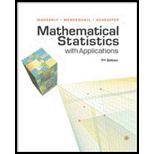
Concept explainers
a.
Find the value of
Check and explain whether the value of
b.
Verify that the confidence interval obtained on the display is correctly calculated.
c.
Explain whether the obtained interval contains the true value of p.
d.
Find the length of the confidence interval for the obtained confidence interval.
Check whether it is exactly the same as the confidence interval obtained in Figure 8.8.
e.
Check whether the new interval obtained is different from the previous one.
Find the number of distinctly different intervals that appear among the first 5 intervals generated.
Identify the number of intervals that contain 0.5.
f.
Find the percentage of the intervals that contain the true value of p=0.5.
Explain whether the percentage is close to the value that is expected.
Want to see the full answer?
Check out a sample textbook solution
Chapter 8 Solutions
Mathematical Statistics with Applications
- 1. [10] Suppose that X ~N(-2, 4). Let Y = 3X-1. (a) Find the distribution of Y. Show your work. (b) Find P(-8< Y < 15) by using the CDF, (2), of the standard normal distribu- tion. (c) Find the 0.05th right-tail percentage point (i.e., the 0.95th quantile) of the distri- bution of Y.arrow_forward6. [10] Let X, Y and Z be random variables. Suppose that E(X) = E(Y) = 1, E(Z) = 2, V(X) = 1, V(Y) = V(Z) = 4, Cov(X,Y) = -1, Cov(X, Z) = 0.5, and Cov(Y, Z) = -2. 2 (a) Find V(XY+2Z). (b) Find Cov(-x+2Y+Z, -Y-2Z).arrow_forward1. [10] Suppose that X ~N(-2, 4). Let Y = 3X-1. (a) Find the distribution of Y. Show your work. (b) Find P(-8< Y < 15) by using the CDF, (2), of the standard normal distribu- tion. (c) Find the 0.05th right-tail percentage point (i.e., the 0.95th quantile) of the distri- bution of Y.arrow_forward
- == 4. [10] Let X be a RV. Suppose that E[X(X-1)] = 3 and E(X) = 2. (a) Find E[(4-2X)²]. (b) Find V(-3x+1).arrow_forward2. [15] Let X and Y be two discrete RVs whose joint PMF is given by the following table: y Px,y(x, y) -1 1 3 0 0.1 0.04 0.02 I 2 0.08 0.2 0.06 4 0.06 0.14 0.30 (a) Find P(X ≥ 2, Y < 1). (b) Find P(X ≤Y - 1). (c) Find the marginal PMFs of X and Y. (d) Are X and Y independent? Explain (e) Find E(XY) and Cov(X, Y).arrow_forward32. Consider a normally distributed population with mean μ = 80 and standard deviation σ = 14. a. Construct the centerline and the upper and lower control limits for the chart if samples of size 5 are used. b. Repeat the analysis with samples of size 10. 2080 101 c. Discuss the effect of the sample size on the control limits.arrow_forward
- Consider the following hypothesis test. The following results are for two independent samples taken from the two populations. Sample 1 Sample 2 n 1 = 80 n 2 = 70 x 1 = 104 x 2 = 106 σ 1 = 8.4 σ 2 = 7.6 What is the value of the test statistic? If required enter negative values as negative numbers (to 2 decimals). What is the p-value (to 4 decimals)? Use z-table. With = .05, what is your hypothesis testing conclusion?arrow_forwardPeriodically, Merrill Lynch customers are asked to evaluate Merrill Lynch financial consultants and services (2000 Merrill Lynch Client Satisfaction Survey). Higher ratings on the client satisfaction survey indicate better service with 7 the maximum service rating. Independent samples of service ratings for two financial consultants are summarized here. Consultant A has 10 years of experience, whereas consultant B has 1 year of experience. Use = .05 and test to see whether the consultant with more experience has the higher population mean service rating. Consultant A Consultant B = 16 = 10 = 6.82 = 6.25 = .64 = .75 State the null and alternative hypotheses.H0: 1 - 2 Ha: 1 - 2 Compute the value of the test statistic (to 2 decimals). What is the p-value?The p-value is What is your conclusion?arrow_forwardA firm paid its first annual dividend yesterday in the amount of $.15 per share. The company plans to double the dividend in each of the next 3 years. Starting in Year 4, the firm plans to pay $1.50 per share indefinitely. What is one share of this stock worth today if the market rate of return on similar securities is 13.8 percent? Multiple Choice $11.79 $8.92 $10.77 $11.02 $10.26arrow_forward
- Suppose the random variable X is normally distributed with mean 80 and standard deviation 16. Find following probabilities. Find ‘b’ such that P(X ≥ b) = 0.975. Find the probability using a normal distribution table AND using ti-83 calculator. SHOW ALL STEPS PLEASE.arrow_forwardSuppose the random variable X is normally distributed with mean 80 and standard deviation 16. Find following probabilities. Equation: P(85 ≤ X ≤ 102). Find the probability using a normal distribution table AND using ti-83 calculator. SHOW ALL STEPS PLEASE.arrow_forwardData set is Bachelor Degree's Conferred by Race and Ethnicity.arrow_forward
 College Algebra (MindTap Course List)AlgebraISBN:9781305652231Author:R. David Gustafson, Jeff HughesPublisher:Cengage Learning
College Algebra (MindTap Course List)AlgebraISBN:9781305652231Author:R. David Gustafson, Jeff HughesPublisher:Cengage Learning Glencoe Algebra 1, Student Edition, 9780079039897...AlgebraISBN:9780079039897Author:CarterPublisher:McGraw Hill
Glencoe Algebra 1, Student Edition, 9780079039897...AlgebraISBN:9780079039897Author:CarterPublisher:McGraw Hill Holt Mcdougal Larson Pre-algebra: Student Edition...AlgebraISBN:9780547587776Author:HOLT MCDOUGALPublisher:HOLT MCDOUGAL
Holt Mcdougal Larson Pre-algebra: Student Edition...AlgebraISBN:9780547587776Author:HOLT MCDOUGALPublisher:HOLT MCDOUGAL



